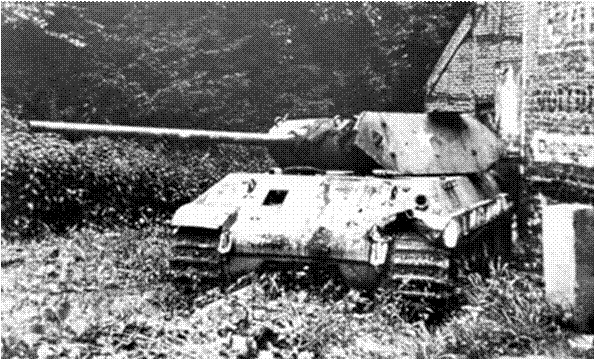 |
| Hitler, seen here with general officers studying a map, was the principal German strategist for the Ardennes offensive. |
 |
| General Alfred Jodl, head of the operations staff of the OKW at the time of the Battle of the Bulge. |
 |
| Field Marshal Walter Model, commander of Army Group B at the time of the Battle of the Bulge. |
 |
| SS-Sergeant Ernst Barkmann, commander of Panzer 401, a Panther of the 4th Panzer Co., at the time of the Battle of the Bulge. |
 |
| Major Gerhard Tebbe, Panther tank battalion commander during the Battle of the Bulge. |
 |
| Generalleutnant Fritz Bayerlein, commander, Panzer Lehr Division, at the time of the Battle of the Bulge. |
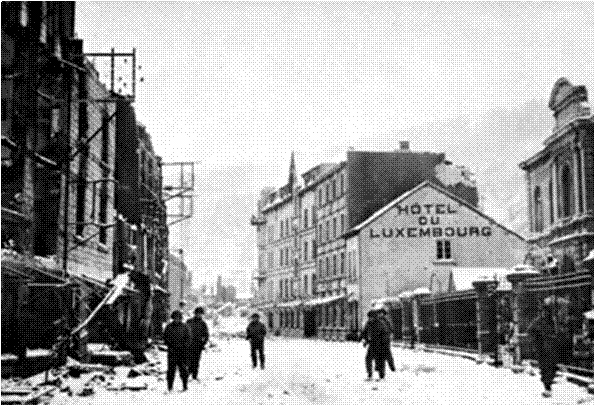 |
| American soldiers hunting for German snipers in La Roche, France. |
 |
| Dead GIs at a crossroads were stripped of much of their equipment, including their shoes, by the German forces during the Ardennes offensive. Honsfeld, 17 December 1944. |
 |
| American infantrymen of the 290th Regiment fight in fresh snow near Amonines, Belgium, in January 1945. |
 |
| American soldiers stringing barbed wire as a defensive measure in the event of another enemy counterattack. |
 |
| American soldiers stringing barbed wire during a blizzard. |
 |
| Staff Sergeant Joseph Arnaldo, of New Bedford, Massachusetts, during the Battle of the Bulge. |
 |
| American POWs taken during the early stages of the Battle of the Bulge are on their way back to Germany and imprisonment for the rest of the war. |
 |
| American infantrymen batter down the door of a house where German snipers are holding out in the town of Stavelot. |
 |
| American combat engineers blow a bridge over a river during the Battle of the Bulge. |
 |
| GIs line up for a movie at the quiet backwater town of Malmédy, five days before the German Ardennes counteroffensive began in December 1944. |
 |
| A soldier of the Third Army works his way forward under a barbed wire fence about five miles from Bastogne. |
 |
| Bodies of American soldiers lie in the snow after the so-called Malmédy massacre. |
 |
| Towns in the Ardennes are small and usually fall into one of two types: a cluster of houses at a crossroads, such as Noville … |
 |
| … and a river valley settlement, such as Stolzemburg on the Our. |
 |
| Joseph Sepp Dietrich. |
 |
| Snow scene near Krinkelt. |
 |
| Losheimergraben, Germany. |
 |
| Constructing a winterized squad hut near the front lines. |
 |
| Camouflaged pillbox in the forest serves as a regimental command post. |
 |
| American engineers unloading barbed wire which was used in defensive measures against counterattacks. |
 |
| Waffen-SS troops dash across a road during their Ardennes Offensive, December 1944. The burning vehicle behind them is an M8 armored car of the 14th Cavalry Group. |
 |
| American troops and an M4 medium tank pass through Lierneux, Belgium, en route to the Ardennes. |
 |
| M4A1 76mm medium tank, knocked out, Ardennes. |
 |
| A member of a U.S. cavalry reconaissance squadron checks his vehicle mounted .30 caliber machine gun covered by frost, Battle of the Bulge, December 1944. |
 |
| Browning M1917 .30 cal. water-cooled machine gun well dug-in during the Battle of the Bulge, December 1944. |
 |
| German infantry on the march in the Ardennes, December 1944. The first man carries a Panzerfaust and the second man a MG 42 machine gun, for which they are all carrying spare ammunition belts. |
 |
| Covered with white camouflage, an infantryman assumes a prone firing position on frozen ground outside St. Vith as Americans retook the town from the Germans. |
 |
| 155mm M1 howitzer beneath a camouflage net covered with snow in the Ardennes, December 1944. |
 |
| Use of foliage and tarpaulin plus recently fallen snow to conceal 2½-ton 6x6 truck, 6th Armored Division, winter 1944-45. |
 |
| 8-inch howitzers and their prime mover tractors move along a snow-covered road in Belgium, December 1944. |
 |
| GIs of the 413th Infantry Regiment, 104th Infantry Division “Timberwolf Division,” resting on the rails after combat in Düren, town in North Rhine-Westphalia, Germany, 21 December 1944. |
 |
| Camouflaged M29 transports wounded, Belgium, 1944. |
 |
| American infantrymen pause on a road on the outskirts of St. Vith, Belgium. |
 |
| American soldiers hunting for German snipers in La Roche, France. |
 |
| Severe winter conditions in the Bulge hamper movements of troops and equipment, winter 1944-45. |
 |
| Soldiers of U.S. First Army hacking at frozen ground to dig foxholes near their machine gun position during a lull. |
 |
| American soldiers of the First Army huddle around campfire in the snowy countryside of northern Ardennes Forest during lull in the Battle of the Bulge. |
 |
| Hard going for U.S. tanks at Amonines, Belgium, on the northern flank of the Bulge. January 1945. |
 |
| Allied aircraft vapor trails in skies above U.S. soldier unloading a jeep outside a farmhouse in the Ardennes Forest. |
 |
| German POWs carrying body of American soldier killed in the Bulge through snowy Ardennes field. |
 |
| American troops man the trenches along a snowy hedgerow in the northern Ardennes Forest during the Battle of the Bulge. |
 |
| This American soldier shaves in the cold during a lull in the fighting in the Battle of the Bulge. |
 |
| An American Sherman M4 tank moves past another gun carriage that slid off icy road in the Ardennes Forest during push to halt advancing German troops. |
 |
| Soldiers with the 7th Armored Division trudge through snow in a bombed-out Belgian village in 1945. |
 |
| An American soldier, just back from the front lines near the town of Murrigen, shows signs of fatigue 1 January 1945. |
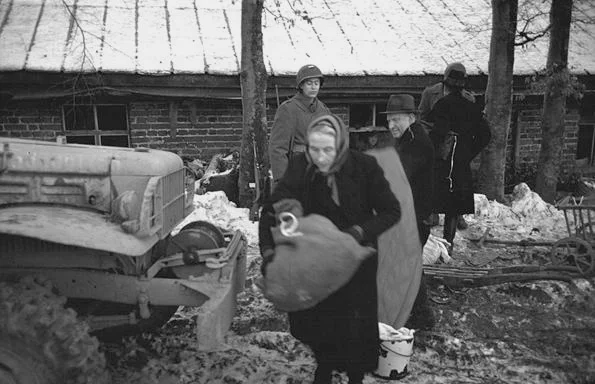 |
| American GIs helped local residents to load themselves and their belongings onto U.S. trucks so they could escape the fight. |
 |
| This German plane was shot down by Allied guns and was found lying in a snowy field in the Ardennes Forest. |
 |
| German prisoners of war hold up their arms as Allied soldiers round up captives 20 January 1945 near the French-German border |
 |
| German soldiers aboard a Jagdpanzer IV/70 tank destroyer from the 12th SS Panzer Division during the Bulge. |
 |
| A heavily armed German soldier during the Ardennes Offensive, December 1944. |
 |
| Men of 7th Armored Division manning a 3-inch M5 anti-tank gun at a road near Vielsalm, Belgium, 23 December 1944. |
 |
| Von der Heydte during the Ardennes Offensive, December 1944. |
 |
| Armored reconnaissance jeep of 82nd Airborne Division, Ardennes Forest, Belgium, December 1944. |
 |
| German prisoners taken during the Battle of the Bulge, circa late December 1944. |
 |
| 5th Armored Regiment tankers gathering around a fire and opening Christmas presents next to their M4 medium tank, near Eupen, Belgium, 30 December 1944. |
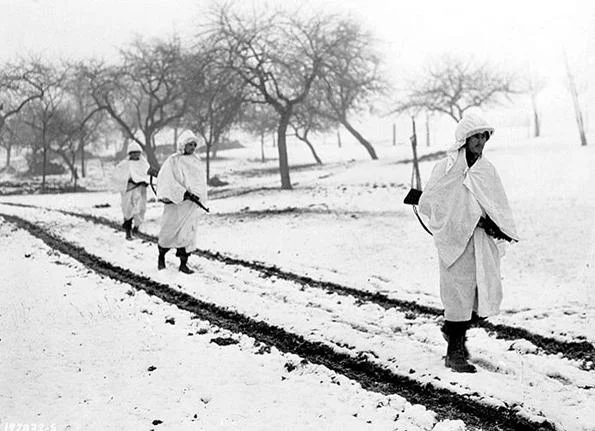 |
| Sergeant James Storey, Private Frank Fox, and Corporal Dennis Lavanoha, wearing bedsheets for camouflage, on a scouting mission, Lellig, Luxembourg, 30 December 1944. |
 |
| Dead German soldier in Stavelot, Belgium, 2 January 1945. |
 |
| M36 gun motor carriage, camouflaged in white, operating near Dudelange, Luxembourg, 3 January 1945. |
 |
| Men of 290th Infantry Regiment in snowy terrain near Amonines, Belgium, 4 January 1945. |
 |
| Jeeps, Dodge WC54 ¾-ton field ambulances, and U.S. troops on a street in the heavily damaged town of Foy, Belgium, 16 January 1945. |
 |
| M8 armored car of the 101st Airborne Division in Noville, Belgium, 16 January 1945. |
 |
| Men of the 1st Infantry Division checking out a gasoline truck that had skidded off the road due to snow and ice, Sourbrodt, Belgium, 19 January 1945. |
 |
| Men of Company I, 3rd Battalion, 16th Infantry Regiment, 1st Infantry Division, riding on M4 medium tank at Schopen, Belgium, 21 January 1945. |
 |
| Here is a portion of the wreckage in St. Vith, Belgium, after units of the 7th Armored Division took the town. |
 |
| This dug-in mortar emplacement near St. Vith, Belgium, is manned by, left to right, Pvt. R.W. Fierde, S/Sgt. Adam J. Celinca, and T/Sgt. W.O. Thomas, 24 January 1945. |
 |
| Vehicles of the U.S. 87th Infantry Division in the woods near Wallerode/St. Vith, Belgium, on 30 January 1945. |
 |
| A belated Christmas gift being delivered during the Battle of the Bulge. |
 |
| 506th PIR bazooka team. |
 |
| Rochefort, Belgium, 29 December 1944. |
 |
| A U.S. Army combat engineer sets a charge in the Ardennes. When the charge detonates, the tree will fall across the road creating a partial roadblock. Belgium, December 1944. |
 |
| A U.S. Army Signal Corps cameraman films GIs in the snow with his Bell & Howell 35mm Eyemo motion picture camera during the Battle of the Bulge, 1944. |
 |
| American soldier examines bullet holes in the side of an American ambulance during the Battle of the Bulge. |
 |
| Wounded medic, Battle of the Bulge. |
 |
| German soldier with Panzerfaust during the Battle of the Bulge. |
 |
| Vehicles and infantry of the U.S. 1st Army on the road during the Battle of the Bulge. |
 |
| Medic Don Rinella, Malmédy, Belgium, 1944. |
 |
| Christmas Eve, 99th Infantry Division. |
 |
| German soldier captured while wearing a GI overcoat. |
 |
| 101st Airborne paratrooper fills his canteen cup with snow for making coffee, near Foy, Belgium, December 1944. |
 |
| German soldiers in a Schwimmwagen drive through the Kaiserbaracke crossroads, December 1944. |
 |
| German infantry advancing during the Battle of the Bulge; two soldiers pass a burning vehicle from the 14th Cavalry Group. |
 |
| SS troops capture American GIs during the Battle of the Bulge. |
 |
| A soldier of the 535th Anti-Aircraft Artillery Battalion, 99th Infantry Division, with his pup during the Battle of the Bulge, somewhere in Belgium on January 4, 1945. |
 |
| 324th Medical Battalion, 99th Infantry Division, December 1944. |
 |
| A soldier prepares to bed down for the night in a Belgian forest during the Battle of the Bulge. December 21, 1944. |
 |
| A VW Type 82 abandoned during fighting in the Ardennes. |
 |
| U.S. soldiers helping push a jeep carrying wounded German soldiers through the snow during the Battle of the Bulge, January 1945. |
 |
| German infiltrator lined up for execution by firing squad after conviction by a military court for wearing U.S. uniforms during the Battle of the Bulge. December 23, 1944. |
 |
| Another German infiltrator lined up for execution by firing squad after conviction by a military court for wearing U.S. uniforms during the Battle of the Bulge. December 23, 1944. |
 |
| An American machine gun crew man their .30-caliber water-cooled machine gun, dug in near St. Vith. |
 |
| Three German assault guns knocked out and abandoned along the road to St. Vith as found on 23 January during the 7th Armored Division’s drive to recapture the town. |
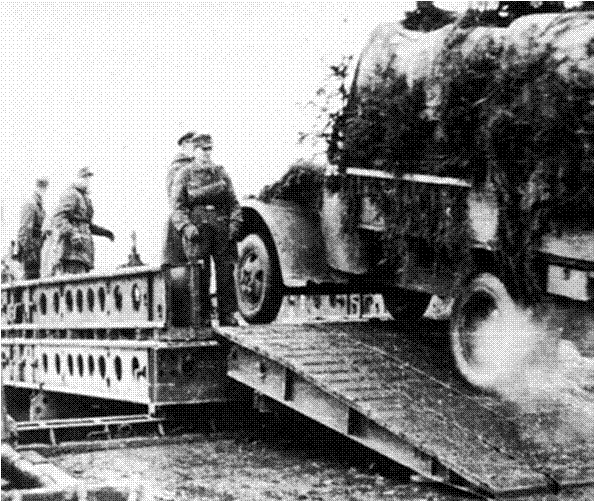 |
| A German supply column crossing a captured American bridge. Von Manteuffel’s attack was delayed due to the inability of inexperienced German engineers to span the Our River. |
 |
| A knot of paratroopers set up a machine gun by a fence and hedge close to the burning Panther, from whose crew only SS-Rottenführer Heinz Hofmann escaped alive. |
 |
| A graveyard of SdKfz 251 half-tracks: the mounts of SS Panzer Grenadier Regiment 2 lie scattered across the orchard below La Gleize. |
 |
| German paratroopers riding on the deck of a Panzerkampfwagen VI Tiger II during the Ardennes Offensive. Note the man standing holding the Sten gun. |
 |
| The crew of a Wirbelwind lend a hand to mop up small pockets of resistance in Stoumont on 19 December, using a variety of small arms; again, note heavy foliage camouflage. |
 |
| The battle over, a Wirbelwind stands abandoned outside the hotly-contested 'Festung Sankt-Edouard' in Stoumont. |
 |
| PzKpfw VI Tiger II heavy tank passes a line of American soldiers captured in the Battle of the Bulge. |
 |
| Panzerkampfwagen VI Tiger II, number 105, commanded by Jürgen Wessel, immobilized in the rue Hat Rivage, Stavelot, 18 December 1944. |
 |
| Panzerkampfwagen VI Tiger II, possibly the same tank as in the previous photo, knocked out during the bitter fighting for the small town of Stavelot. |
 |
| Tiger II knocked out by 6th Armored Division, near Wardin, 12 January 1945. Note the shell holes in the side of the hull and turret. |
 |
| Panzerkampfwagen VI Tiger II, number 204, near the Petit Spai bridge after the battle, in January 1945. |
 |
| Tiger II, knocked out in La Gleize in December 1944 during the battle of the Bulge, being examined by British troops at a later date. |
 |
| The burned-out hulk of a Tiger II tank of Peiper’s kampfgruppe lies abandoned along a road in La Gleize after the Battle of the Bulge. |
 |
| Panzerkampfwagen V Panther, number 131, commanded by Oberscharführer Strelow, immobilized in an air attack on 18 December 1944. The Cheneux bridge is in the background. |
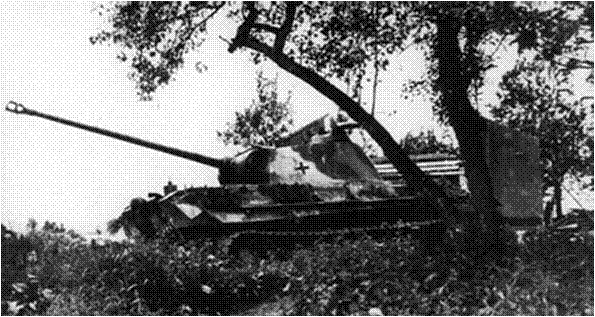 |
| Panzerkampfwagen V Panther, number 002, abandoned in La Gleize after the battle. The number would indicate it was a command tank of Peiper’s kampfgruppe headquarters. |
 |
| Panzerkampfwagen V Panther, number 221, commanded by Hauptscharführer Knappisch, in La Gleize after the battle. It was damaged during the attack on Stoumont. |
 |
| Waffen-SS troops work to free a bogged-down Schwimmwagen from the slush and mud on a road in the Ardennes, December 1944. |
 |
| Sergeant Karl Wortmann, served with Kampfgruppe Peiper during the Battle of the Bulge. |
 |
| A close-up of the Waffen-SS officer and his driver in their Schwimmwagen at the Kaiserbaracke crossroads, 18 December. |
 |
| German self-propelled 150mm artillery in the pre-dawn light of 16 December. The vehicles are heavily camouflaged with pine boughs. |



































